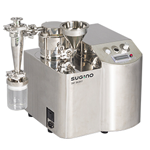We’re back this week with an installment of our weekly series, Deburring 101. Let’s kick it off with some deburring basics.
What is a burr?
Merriam Webster defines a burr as “a thin ridge or area of roughness produced in cutting or shaping metal.”
Wikipedia says, “A burr is a raised edge or small piece of material that remains attached to a workpiece after a modification process.”
But while correct, these definitions don’t emphasize the problems that burrs cause within the manufacturing process. Whenever you are machining metal, burrs are going to be a byproduct of the process. Burrs are an inherent part of manufacturing and need to be prevented or removed as efficiently as possible. How they get removed depends a lot on how they are classified. With some basic understanding, you can consider the types of deburring available. Every industry has unique specifications, and the deburring method you choose should be the right fit for the objectives and standards you are trying to accomplish.

We’ve defined what a burr is. Equally important is understanding the problems burrs cause. The challenges vary, but they generally fall into a few categories:



Production Problems
Production or equipment problems can happen in your production line
downstream from whatever is creating (and not filtering out) burrs. This can cause blockages, damage, work stoppage or other issues.
Workpiece Issues
Burrs can also create workpiece problems such as part failure or weak spots. For some industries, imperfections could mean the difference between function and failure.
Safety Risks
Loose or attache burrs can cause safety hazards like lacerations or other injuries caused by malfunctioning equipment or flawed parts. On top of that, using human operators to deburr by hand comes with it’s own set of hazards.
It’s clear that burrs are problematic, but next week we’ll take a deeper look at the problems they create, and how to minimize the risk to your production process, your parts, and to your team.
For more in the Deburring 101 series, click:
See the next installment: Why Deburr
We welcome your participation, so please let us know if you have specific questions you would like addressed.
Follow along on social media:

















